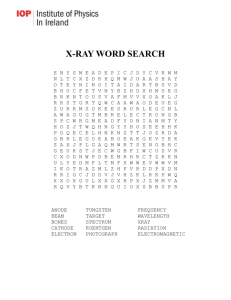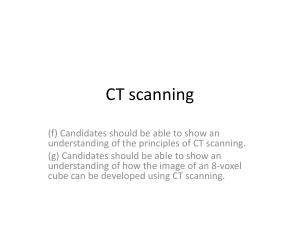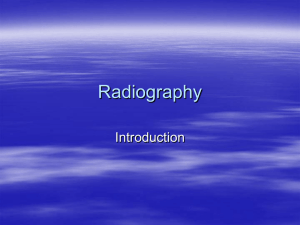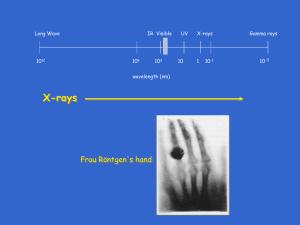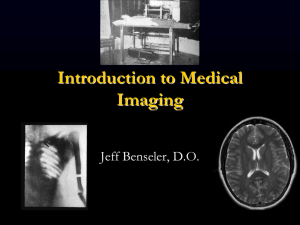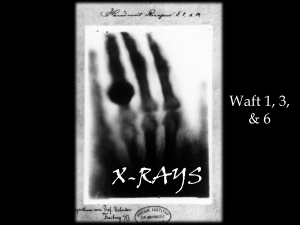X-Ray Spectro-Microscopy - Stanford Synchrotron Radiation
advertisement
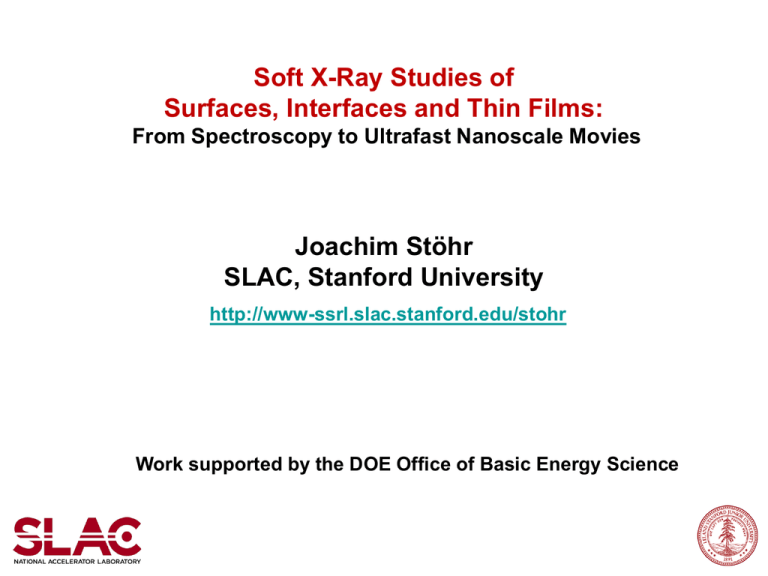
Soft X-Ray Studies of Surfaces, Interfaces and Thin Films: From Spectroscopy to Ultrafast Nanoscale Movies Joachim Stöhr SLAC, Stanford University http://www-ssrl.slac.stanford.edu/stohr Work supported by the DOE Office of Basic Energy Science Overview of my talk The Power of Soft X-rays Polarized X-Ray Absorption Spectroscopy Liquid crystal alignment on surfaces X-Ray Spectro-Microscopy Ferromagnetic alignment on an antiferromagnetic surface Time Dependent X-Ray Spectro-Microscopy Switching of magnetic nano-structures with spin currents A Glimpse of the Future What are soft x-rays anyway? Soft X-Rays VUV Hard X-Rays 30 eV 100 eV ~ 10 nm 1000 eV ~1 nm 3000 eV Opening the soft x-ray region – late 1970s Stanford Synchrotron Radiation Lab Grasshopper monochromator Photon flux Oxygen SEXAFS oxidized Al surface 12/ 5/1977 500 eV 800 eV O K-edge Spectroscopy in the important region 280 – 1000 eV became possible Photon energy (eV) Tunable x-rays offer atom specific valence shell information through guided transitions polymer magnetic multilayer Element specificity, Chemical specificity, Valence properties Polarized x-ray absorption determines charge and spin orientation Orientational order of bonds Antiferromagnetic order Ferromagnetic order Use of soft x-rays to solve a 100 year old puzzle Liquid crystal alignment on rubbed polymer surfaces …discovered in 1907… Note LC “pretilt” out of plane Alignment is basis of liquid crystal displays A $30 billion world-wide business Conventional models of alignment mechanism Oldest model assumes micro grooves in polymer surface X-ray diffraction on polyimide suggests epitaxy-like nucleation Models cannot explain LC “pretilt” angle up from plane A key observation in 1998: Directional ion beam irradiated polymers also align liquid crystals Pretilt direction is opposite ! X-ray spectroscopy of ion beam modified polymer surface reference sample • LCs align on a-carbon surface layer, not on polymer substrate • Is LC alignment due to bond orientation on substrate surface? Do not need polymers at all ! start with a-Carbon – align with ion beam • Rubbing and ion beam create molecular level orientational order • Highest resolution displays today use ion beam aligned carbon films Nature 411, 56 (2001); Science 292, 2299 (2001) Polarization Dependent Imaging with X-Rays Ferromagnetic regions Oriented molecular regions Antiferromagnetic regions Tackling a 50 year old mystery with x-rays: “Exchange bias” Key modern magnetic building blocks are based on fixed (“pinned”) ferromagnetic reference layers turns in external fields: “0” or “1” bits Reference layer does not turn in external fields pinned by antiferromagnet How can a “neutral“ antiferromanet bias a ferromagnet? Effect remained a puzzle ever since its discovery in 1956 Conventional techniques could not study the all-important interface X-Rays reveal interfacial coupling of FM and AFM domains Electron Yield Co edge – use circular polarization – ferromagnetic domains 2nm 8 Co XMCD 4 s 0 776 780 778 Photon Energy (eV) Ni edge – use linear polarization – antiferromagnetic domains Electron Yield 15 NiO XMLD 10 5 [010]s 0 H. Ohldag et al., PRL 86, 2878 (2001) 870 874 Photon Energy(eV) 2mm X-Rays-in / Electrons-out: A way to study thin film interfaces pure Co/NiO pure pure Co/NiO pure Interface is mixed CoNiOx layer - is it magnetic? Images of the Ferromagnet-Antiferromagnet Interface Interface layer contains ferromagnetic NiOx - is it coupled to AFM NiO? Ohldag et al., PRL 87, 247201 (2001) Exchange bias model • • • • • A thin interfacial diffusion layer (1–2 layers) of CoNiOx is formed Interface layer contains ferromagnetic Ni spins from modified NiO About 95% of interfacial Ni spins rotate with FM (not pinned) Only < 5% of interfacial Ni spins are pinned to bulk NiO This tiny fraction is the origin of exchange bias Ohldag et al PRL 91, 017203 (2003) What have we learned so far ? • Interface effects play import role in modern nanoscale materials • Suble interface properties can lead to important phenomena • Soft x-rays are powerful tool to reveal interface-specific effects elemental specificity chemical specificity magnetic specificity orientational specificity nanoscale spatial resolution The new frontier: dynamics or “the need for speed” Drivers of Modern Magnetism Research: Smaller and Faster Operational Timescales The ultrafast technology gap The goal Fundamental Timescales Time Resolution: Pulsed X-Rays from Electron Storage Ring Bunch width ~ 50 ps Bunch spacing 2 ns beam line pulsed 50 ps x-rays State-of-the art ultrafast electronics : Y. Acremann et al., Rev. Sci. Instr. 78, 14702 (2007). J. P. Strachan et al., Rev. Sci. Instr. 78, 54703 (2007). From reading to writing information Suggested by J. Slonczewski & L. Berger in 1996 “spin torque switching” – no external magnetic field ! free fixed Verified by: F.J. Albert, J.A. Katine, R.A. Buhrman, D. Ralph, Appl. Phys. Lett. 77, 3809 (2000) Time-Resolved Scanning Transmission X-Ray Microscopy X-ray image 2 nm magnetic layer buried in 250nm of metals 100nm ~100 nm current 5mm Detector leads for current pulses Y. Acremann et al., Phys. Rev. Lett. 96, 217202 (2006) Spin Torque Switching: 180nm x 110nm x 2 nm nanostructure of CoFe t=0 + _ switch current pulse switch back 100 nm 200ps 400ps 600ps 800ps Y. Acremann et al., Phys. Rev. Lett. 96, 217202 (2006) J. P. Strachan et al., Phys. Rev. Lett. 100, 247201 (2008) Vortices are important on all length scales Hurricane Nano-element 100 km Milky Way ~ 50nm 100,000 light years = 1018 km A Glimpse of the Future X-ray snap shots on the fundamental time scales of motion of atoms, electrons and spins ….femtoseconds and faster…. The Light Fantastic Birth of the X-Ray Laser …..and a New Era of Science The End


